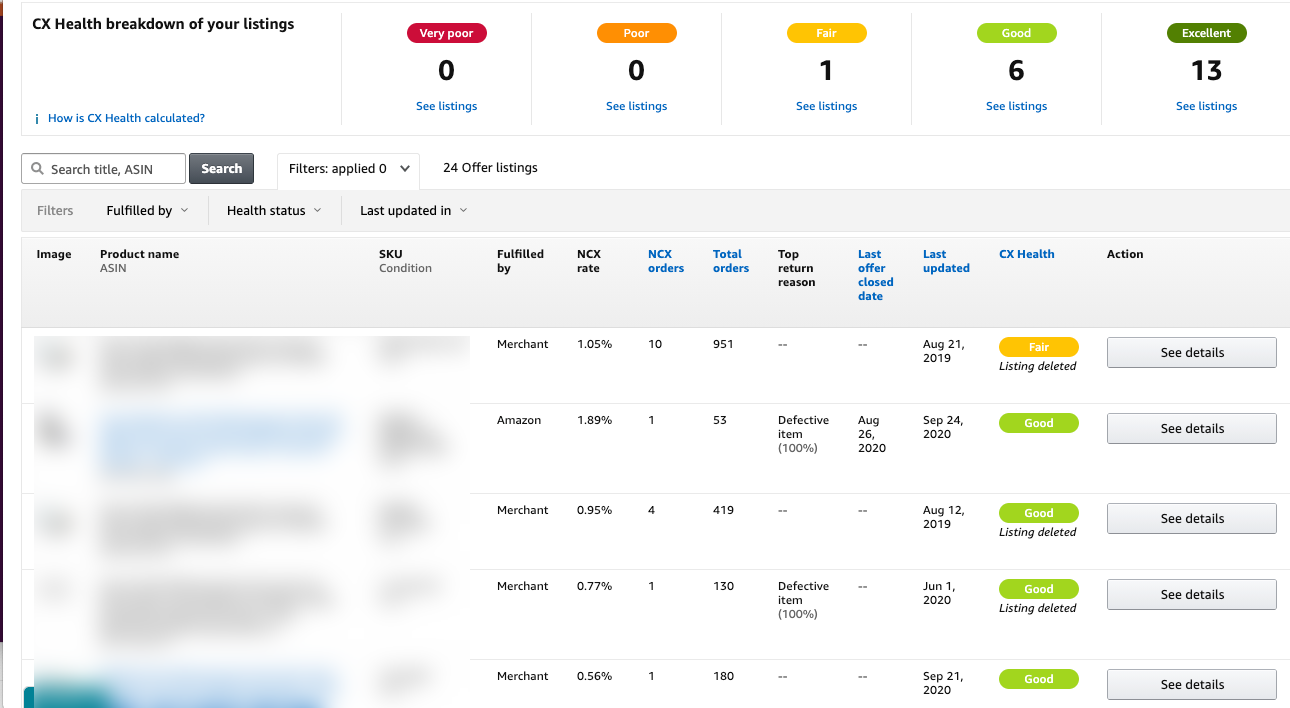Every November, Amazon sellers buzz with excitement.
During the November and December holiday season, sellers can rake in as much in sales as during the rest of the year combined.
A company’s preparation for the fourth quarter (Q4) sales can make or break its profitability for 2020.
This year, there is an even greater potential for sales as the pandemic has driven more people than ever to shopping online.
It has also caused a massive supply chain and logistics challenge for Amazon and its independent sellers.
While 2020 is impossible to predict, following recognized best practices can help sellers prepare for this year’s Christmas sales boom.
1. Solidify Your Logistics
We have been cautioning our clients that, this year more than any other in history, logistics will be the lynchpin to success in Q4.
We usually see Amazon’s warehouses backing up sometime between October and November.
This year, warehouses have experienced significant delays in receiving since June.
As sellers begin to prep for the deluge of holiday sales at the end of the year, you can expect warehouses to become even more sluggish in receiving products.
What usually takes you seven days to restock may consume three or four weeks.
Amazon recently announced several new limits that will change how sellers restock their Fulfillment by Amazon (FBA) inventory.
The company has limited many products to restocking no more than 200 units at a time.
On top of that restriction, Amazon has also drastically limited storage for many sellers.
This means sellers will need to send smaller, more frequent shipments to Amazon.
As the warehouses get busier and receiving times extend, sellers could face costly stockouts during the most active season of the year.
Here are some strategies we recommend to better prepare for Q4 shipping.
Avoid Less Than Truckload (LTL)
While LTL shipments are generally less expensive than small parcels (sending via UPS with Amazon partnered shipping), Amazon takes longer to receive them.
Make sure you use Small Parcel or Full Truck Loads (FTL) to expedite shipping.
If you are at all interested in Premium Placement, you want to apply for that immediately.
Slim Down Your SKUs
If you have been limited in the total amount of inventory storage you can carry, consider reducing your number of SKUs.
This allows you to send more products of each SKU into fulfillment, providing a longer lead time of inventory.
Be Ready to Pivot to Merchant Fulfilled
It is an accepted best practice that having an FBA offer is crucial to success on Amazon, but this year is anything but ordinary.
While having Prime offers for all your products is still recommended, you should also create a Merchant Fulfilled (MF) SKU and have stock to be available to ship from your location or your 3PL partner.
If your product cannot be stocked through FBA because of delays or storage limits, having that MF option will be critical to extending your holiday selling season, allowing you to maximize your total sales for the year.
In general, MF orders do not sell as quickly as products available through FBA.
But your MF item will sell if there are no other FBA offers or if your competitors are also out of the Buy Box because of shipping restrictions and delays.
We’ve seen that, at the height of the lockdowns, many MF offers sold even better than FBA offers because of delays at Amazon warehouses.
2. Audit Your Listings
Q4 can dramatically increase the number of eyes on your products, so it is essential to make sure that, when traffic comes to your listing, that traffic converts.
Confirming that your listings are optimized and following industry best practices can help them convert more consistently.
After optimizing the first time, go back and determine whether your changes have been effective in increasing your conversion.
You can pinpoint this by pulling down the detailed sales and traffic report for your product and looking at the unit session percentage, which is basically your conversion rate at Amazon.
You can use various tools to A/B test your product listings, such as Splitly or Sellerly (currently free).
Amazon also has a split-testing tool, “Management By Experiments,” but, as of this writing, its use is limited to testing your A+ content.
It was announced at the Amazon Accelerate conference earlier this month that Manage Your Experiments would be expanded to test titles and bullets as well.
You can also use the data in the Detailed Sales and Traffic Report by Child to identify changes in page views, sessions, and conversion.

3. Review Your Ad Strategy
Now is the time to review your current ad campaigns and make sure you are:
- Correctly using a campaign structure.
- Employing multiple match types.
- Bidding down ineffective keywords.
Prospective clients often ask us when they should ramp up their ads to optimize performance during the holiday season.
The answer is not that simple.
You don’t want to wait for your peak season to begin ramping up your ads.
We recommend that you start running your ads at least 90 days before the start of your season.
In an ad campaign, it can take up to 30 days for all your keywords to start showing regularly.
Additionally, fewer of your competitors will be running ads before peak season, which makes using ads to rank for a keyword organically easier.
4. Focus on Keyword Ranking
As you develop your ad strategy and audit your listings, it’s important that you identify which keywords you absolutely want to focus on.
We are often approached by potential clients who say, “We’ve optimized our listings, and we’ve done everything we can, but, for some reason, our product still isn’t moving.”
Generally, those sellers have not identified the highly relevant keyword phrases that attract customers who end up purchasing a product.
On Amazon, customers find products primarily through search.
You should have already identified specific keyword phrases that:
- Will bring in highly relevant buyers.
- Have enough search volume to bring in sufficient potential buyers.
- Are within your ad budget to create conversions to rank on the first page.
5. Stress Test Your Systems
Due to the potential receiving and shipping challenges that many anticipate this Q4, more merchants than ever are looking at MF orders from their location in addition to providing FBA offers for their items.
If you plan to pivot to MF orders at some point this holiday season, we recommend that you test your internal systems now, when there are fewer orders.
You should:
- Test how many orders your team can realistically send out per day
- Verify that your handling times will work at your current staffing levels
- Determine what additional supplies or tools you must purchase to make shipping from your location easier
If your team needs to contract with a 3PL (third-party logistics) provider to help with those additional shipments, or if there’s anything in your process that you haven’t tested at high speed, now is the time to do it.
Make sure your system is ready to scale up to meet increased MF sales.
When contracting with a 3PL, you need to ensure that products are always shipped on time and that someone on your team is watching your late shipment rate and, if needed, removing those MF offers.
Important: Having a late shipment rate of over 4% can quickly lead to account suspension.
Testing your processes with some MF offers can help you identify what changes you need to make in your system.
This also allows you to identify quirks in Amazon’s system.
For example, if someone selects one-day shipping, that will override the longer handling time, meaning you have less time to get that product shipped.
Amazon’s policy is that not knowing these things does not absolve you from potential suspension, so make sure you understand the system well before scaling up.
6. Manage Your Supply Chain
Changes in demand and lockdowns around the globe have created worrisome supply chain concerns.
This means that components of your physical product goods could be delayed.
It could also compromise the availability of your shipping or packaging supplies.
As we head into Q4, it is crucial that you allow extra lead time for restocking your goods and are proactive in tracking the availability of all the supplies you need to fulfill your product.
You may also want to start monitoring your main competitors to determine when they stock out.
If your competitor regularly runs out of stock, you may wish to increase your ad spending to target their products or branded keywords to siphon off those sales when they are out of stock.
A stockout can be detrimental to your organic keyword rankings.
If it looks as though you’re going to run out of stock, we recommend that you:
- Remove clippable coupons or discount codes.
- Reduce ad spending.
- Increase the price of your items.
Keep in mind that large price increases can trigger Buy Box suppression, which makes your product unavailable.
Be cautious if your product is available at a lower price through other online retailers.
Staying in stock is primarily important when you are the only seller of a product.
This happens when you’re a manufacturer-exclusive seller or brand owner.
If multiple sellers offer your product, one seller stocking out of a product will not impact your organic ranking.
7. Watch Your Account Health
An account suspension during the holidays is one of the more stressful experiences that an Amazon seller can face.
Reinstatement takes time – sometimes weeks or months.
Avoiding suspension should be a top priority.
You should be monitoring:
- Order defect rate (ODR).
- Shipping performance.
- Policy compliance.
- Voice of the customer.
You can review all your metrics in Seller Central under Performance, Account Health.
Voice of the Customer is available under Performance, Voice of the Customer and it identifies negative customer experiences with your products broken down by SKU.
 Voice of the customer identifies excessive returns and negative feedbacks by SKU for your products.
Voice of the customer identifies excessive returns and negative feedbacks by SKU for your products.8. Review Your Cash Flow
No matter the time of year, managing your cash flow is an integral part of staying in business.
Inventory based businesses are especially challenged when it comes to managing cash flow as inventory can represent a significant portion of your operating costs.
As we head into Q4, you want to look at your supply chain and at your ability to pivot.
If, due to some of the new logistical challenges expected this year, you are unable to send insufficient items through the FBA program, how will that affect your cash flow going into the first quarter?
If warehouses fall significantly behind in their operations, you may not be able to do that last restock for Christmas, meaning your product would be out of stock.
If that’s the case, you need to have enough cash flow to cover your reorder and make it through that next period, depending on your product’s seasonality.
You must hedge the desire to make as many sales as possible during this holiday season by ensuring that, if it doesn’t go as planned or you run into a bump, you can continue selling into the new year.
Selling This Year Will Be Different
While there’s no doubt that this holiday season will be different from the rest, you can count on some fundamentals.
You can expect a surge of customers and warehouses to be backed up.
You can also count on a wonderful community to support you as you maneuver through selling on Amazon.
Your planning and preparation over the next 30 days is the fundamental element that will determine your profitability and sales revenue in Q4.
Making sure that you have created a proactive strategy that allows for a lot of maneuverability will allow you to maximize your sales during the last quarter of 2020.
More Resources:
- How Amazon Brand Registry Works: A Complete Guide
- A Guide To Getting Started With Amazon’s Affiliate Program
- Amazon Brand Analytics: Getting the Most Out of Your Sales on Amazon
- Ecommerce Marketing: The Definitive Guide
Image Credits
All screenshots taken by author, September 2020





